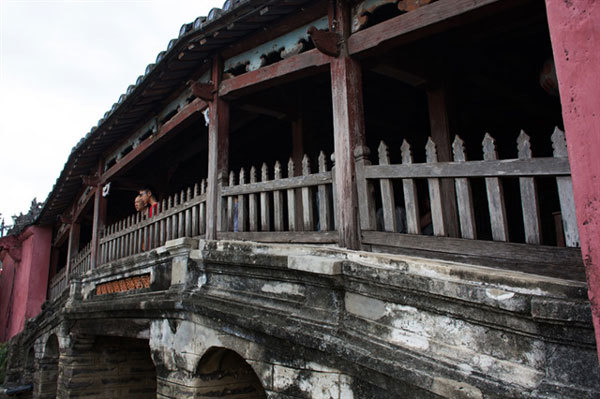Hoi An icon - Japanese Bridge - slated for eighth restoration
Hoi An ancient town – a global cultural heritage
Hoi An ancient town twinkles at night
 |
| Pagoda Bridge in Hoi An may collapse anytime due to serious downgrading problem. — Photo zing.vn |
Cracks in the foundations and main structure, timber girders, beams and rafters have been found in recent years and the situation continues to degrade.
Nguyen Chi Trung, director of the centre, told Văn Hóa (Culture) newspaper that they had to add wood pillars to support the bridge’s body.
“Up to now, Quang Nam Province’s authorities have not decided to assign the bridge restoration project to any unit,” Trung said. “A reason is that financial matters of previous restoration packages have not been solved yet.”
“According to the State’s regulations, in order to set up a new restoration project, it is necessary to solve the financial matter of old projects,” he said.
He said the foundation of the bridge has remained steady since it was fixes. But the wooden body has sloped slightly off of its original axis. The wooden walkway has begun to rot, and roof tiles also need replacing.
According to Phan Van Cam, director of Quang Nam Relics and Landscape Management Centre, small restorations projects for the bridge have been carried out by the centre’s three previous directors.
“Yet documents of the two previous projects have not been completed yet,” he said.
He said the centre has pushed up the document procedure and will complete papers for the two projects within a month.
However, Cam said the delayed documents are only one reason the bridge is in disrepair.
“Previous restoration packages have been small projects focusing on renovating the foundations of the bridge, clearing the waterway under the bridge or building cement banks for the canal,” he said. “They just dealt with supporting facilities at the relic and haven’t fixed the main architecture of the bridge.”
Experts have not reached an agreement on renovating the structure, he said.
At an international workshop in August 2016, experts said any restoration work should solve problems with the inner body of the structure.
According to officials from the Quang Nam Culture, Sports and Tourism Department, financing repairs is not a big challenge.
Cam said the biggest thing is finding a suitable, effective renovation plan.
The funds to renovate the bridge have been taken from the Hoi An Culture Heritage Protection and Management Centre.
Trung, director of the centre, said the bridge has continued to degrade.
“It is impossible to say it may collapse right now,” he said. “But if we do not find a suitable restoration method quickly and implement it right away, the relic will fall into terribly serious disrepair and who knows what could happen.”
The bridge was built by Japanese businessmen in 17th century. In 1653, a pagoda was built adjacent to the northern corridor of the bridge. Since then it has been called the Japanese Bridge.
It measures 20.4m long, 5.7m high and 13m wide, and receives 4,000 visitors each day.
The bridge was listed as a National Culture Relic in 1990.
VNS
 Staff from the Hoi An Culture Heritage Preservation and Management Centre have been mobilized over the past few days to make temporary supports for the main structure of the 400-year-old Japanese bridge, which is damaged and at risk of collapsing.
Staff from the Hoi An Culture Heritage Preservation and Management Centre have been mobilized over the past few days to make temporary supports for the main structure of the 400-year-old Japanese bridge, which is damaged and at risk of collapsing.